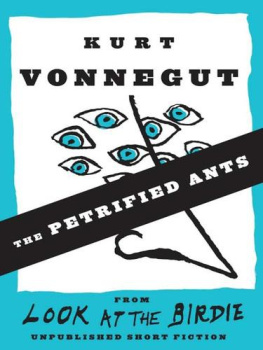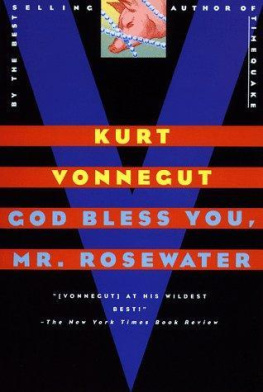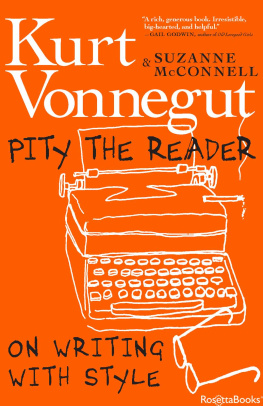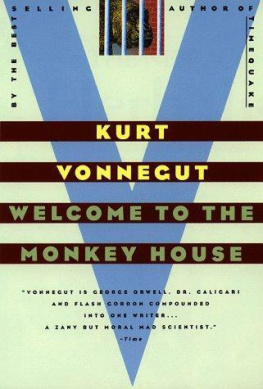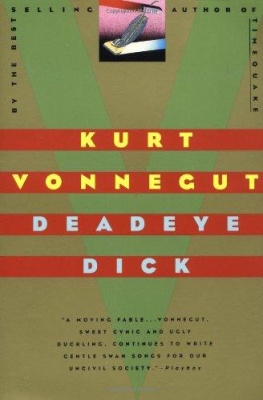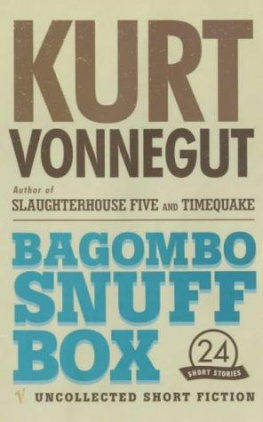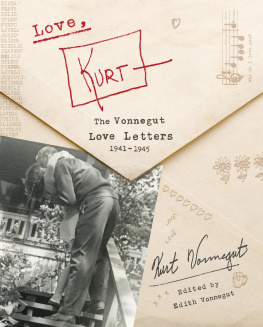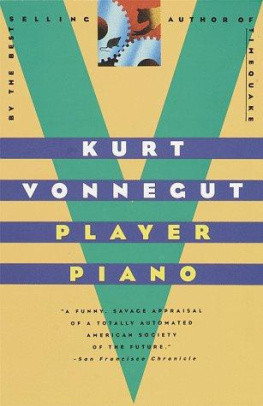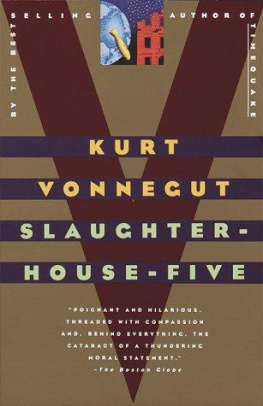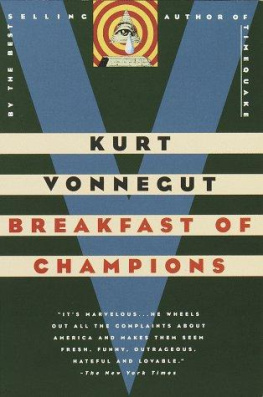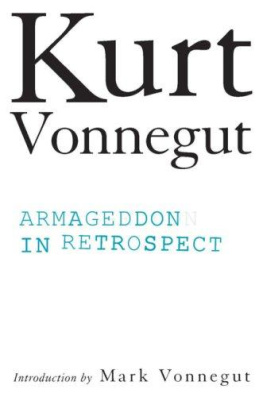
Contents
a cognizant original v5 release october 04 2010
FOREWORD by Sidney Offit As I read this anthology of Kurt Vonneguts previously unpublished short stories, I was reminded of the paradoxical aspects of his personality. Few writers in the history of literature have achieved such a fusion of the human comedy with the tragedies of human folly in their fictionand, I suspect, fewer still have had the grace to so candidly acknowledge them in their presentation of self. During the years of our friendship, though I was aware that he might be suffering private misery, Kurt scuttled his demons with lan as we played tennis and Ping-Pong, skipped off to afternoon movies and jaunts around town, feasted at steak houses and French restaurants, watched football games on television, and twice sat as guests in a box at Madison Square Garden to root for the Knicks. With his signature gentle but mordant wit, Kurt participated in family celebrations, meetings of writers organizations, and our gab and laugh sessions with Morley Safer and Don Farber, George Plimpton and Dan Wakefield, Walter Miller and Truman Capote, Kevin Buckley and Betty Friedan. I dont think it an exaggeration to suggest that I, as well as Kurts other friends, felt that time with Kurt was a momentous gift no matter how light our conversation. We often found ourselves imitating his amused reserve about his own foibles and those of the world. Along with the fun and warm support he so graciously expressed to his friends, Kurt Vonnegut treated me to intimate glimpses of the master storyteller whose ironic and frequently startling observations of people emphasized the moral complexities of life. Walking uptown after a memorial service for an unmarried female author who had devoted her life to literary criticism, Kurt said to me, No children. No books. Few friends. His voice expressed empathic pain. Then he added, She seemed to know what she was doing. At Kurts eightieth birthday party, John Leonard, a former editor of The New York Times Book Review , reflected on the experience of knowing and reading Kurt: Vonnegut, like Abe Lincoln and Mark Twain, is always being funny when hes not being depressed, Leonard observed. His is a weird jujitsu that throws us for a loop. The Vonnegut acrobatics are off to a fast start in this circus of good and evil, fantasy and reality, tears and laughter. The first story, Confido, is about a magical device that provides instant conversation, advice, and therapy to the lonely. Butand here comes the flip sideConfido, the ingenious mind reader, eagerly reveals to its listeners their worse dissatisfactions, leading to painful discomfort with life. This story suggests not only the risks of psychiatry, where the patient may learn too much about himself/herself, but also the drastic spiritual consequences of biting the knowledge-bearing apple. Although I recall Kurt as being appreciative of his brief adventure with psychotherapy, misgivings about the practice of psychiatry are a recurring theme in this collection. Look at the Birdie begins with the narrator sitting at a bar, talking about a person he hates. Let me help you to think about it clearly, the man in a black mohair suit with a black string tie says to him. What you need are the calm, wise services of a murder counselor This bizarre tale is resolved with a version of the old-fashioned O. Henry surprise ending that requires the readers suspension of disbelief. But who can resist the enchantments of a storyteller who has a mad character tell us that a paranoiac is a person who has gone crazy in the most intelligent, well-informed way, the world being what it is? Thats not just jujitsu. Its martial art. Other gems of Kurts wit and verbal play, his dour but just about always humorous commentaries, punctuate these tales. F U B A R, a story title as well as theme, is defined for the reader by the bemused and sometimes mocking narrator as fouled up beyond all recognition. Then we are asked to consider that it is a particularly useful and interesting word in that it describes a misfortune brought about not by malice but by administrative accidents in some large and complex organization. With one brief sentence, the weather in Indianapolis, Kurts hometown, which is the scene for the story Hall of Mirrors, is vividly described. Although the first words of the sentence lead us to expect a lovely nature ramble, the balance surprisingly allows the reader to see, feel, and hear the ugly chill. Autumn winds, experimenting with the idea of a hard winter, made little twists of soot and paper, made the plastic propellers over the used car lot go frrrrrrrrrrrrrrrrrrrrrrrrrrrr . Twenty-eight r s by my count. Hows that for sound effects in prose that says it all, courtesy of Kurt Vonnegut! One of the few stories with an unhappy ending, The Nice Little People provides a preview of the coming attractions of Kurts later career as a novelist. We are engaged by a reversal of the familiar image of larger than life space aliens: In Kurts tale, a platoon of sweet, tiny, insectlike folk descend in a spaceship the size and shape of a paper knife. They turn out to be frightened creatures whom Lowell Swift, a linoleum salesman, befriends. But on guard! The role the aliens play in the resolution of Swifts deteriorating marriage is as harrowing as it is unpredictable. Unpredictable! Hmm. I should have suspected that! Especially with a hero named Swift and a hollow knife handle full of highly sensitive Lilliputian characters. When I asked Kurt what he thought was the most important aspect of the craft of fiction that he taught his students during his years on the faculty of the University of Iowas graduate writing program, as well as Columbia and Harvard, he told me, Development. Every scene, every dialogue should advance the narrative and then if possible there should be a surprise ending. The element of surprise serves, too, to express the paradox of Kurts viewpoint. When all is said and written, the resolution, the surprise, turns the story around and gives it meaning. Unpublished is not a word we identify with a Kurt Vonnegut short story. It may well be that these stories didnt appear in print because for one reason or another they didnt satisfy Kurt. He rewrote and rewrote, as his son, Mark, as well as agents and editors testify. Although Kurts style may seem casual and spontaneous, he was a master craftsman, demanding of himself perfection of the story, the sentence, the word. I remember the rolled up balls of paper in the wastebaskets of his workrooms in Bridgehampton and on East Forty-eighth Street. The closest Kurt ever came to confessing an ambition for his writing was when he recited to me one of his rules for fictional composition: Use the time of a total stranger in such a way that he or she will not feel the time was wasted. To Kurt Vonnegut writing was kind of a spiritual mission, and these stories with all their humor seem most often to be inspired by his moral and political outrage. They are evidence, too, of the volume of Kurts prodigious imagination, a talent that enabled him, after World War II and into the fifties and early sixties, to help support his growing family by contributing short stories to the popular (slick) magazines. Kurt Vonnegut, Jr.s bylines appeared routinely in The Saturday Evening Post, Colliers, Cosmopolitan, Argosy . He later reminded his readers of the satisfactions of this association when he wrote in his introduction to Bagombo Snuff Box , I was in such good company. Hemingway had written for Esquire , F. Scott Fitzgerald for The Saturday Evening Post , William Faulkner for Colliers , John Steinbeck for The Womans Home Companion ! Hemingway! Fitzgerald! Faulkner! Steinbeck! Vonnegut! Their literary legacies survived the demise of so many of the magazines that provided them with generous fees, per word or per line, and introduced them to hundreds of thousands, even millions of readers. Kurts stories selected for this collection are reminiscent of the entertainments of that eraso easy to read, so straightforward as to seem simplistic in narrative technique, until the reader thinks about what the author is saying. They are Kurts magic verbal lantern, the Confido that projects so relentlessly the vagaries and mysteries of human behavior, but with a leavening of humor and forgiveness. The discovery of this sampling of vintage Vonnegut confirms the accessibility that is the trademark of his style and the durability of his talents, a gift to all of usfriends and readers who celebrate the enlightenments and fun of Kurt Vonneguts jujitsus and his art.
Next page

